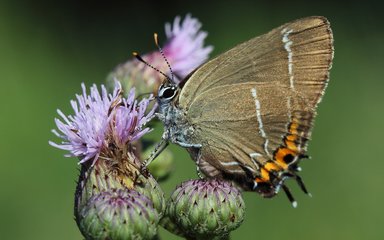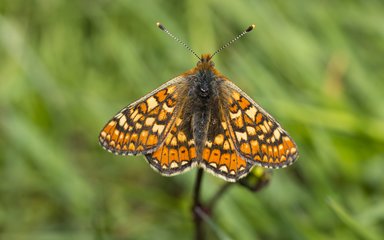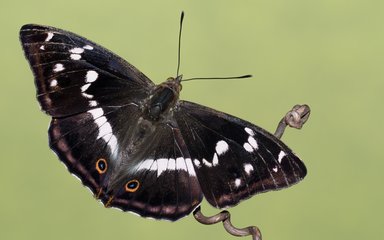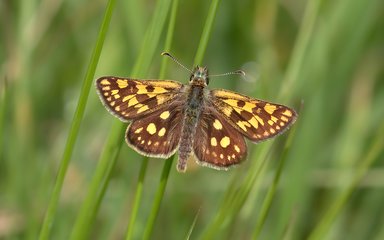Woodlands provide a place to breed for three-quarters of England’s butterfly species. Find out the best places to spot butterflies and discover how we’ve been working to support them.
Over the last century, many of our beautiful butterflies have sharply declined in numbers. Less connected habitat, lack of woodland management and a changing climate are all thought to contribute. We’ve been working alongside partners and dedicated volunteers to boost butterfly habitats in the nation’s forests.
Managing woodlands for butterflies
Many butterfly species are connected to the long history of humans managing woodlands for their resources. The nation’s forests, managed by Forestry England, are a patchwork of different habitats at different stages of the forest’s lifecycle; as some areas are felled, others are being planted. This mosaic of habitats with regular management is key for butterfly lifecycles.
Openings in the forest, called glades, supply warm, sheltered spots for butterflies. Clearings where mature trees have been harvested allow caterpillar foodplants to grow. Thinning out trees, before they mature, also opens up the canopy and encourages other plants. We regularly cut back woodland tracks, known as rides, to stop them growing over.
A woodland with a mix of tree and plant species in various stages of life is not only important for butterflies, but vital for a host of other wildlife too.
Sunny but sheltered areas are great places to spot butterflies, so woodland tracks and clearings are ideal.
Where to spot butterflies
Sunny but sheltered areas are great places to spot butterflies, so woodland tracks and clearings are ideal. You can often find butterflies feeding on brambles in the summer. Some rare species use the tree canopy to feed, so you’ll certainly need your binoculars for that!
One of the likely butterflies you’ll spot in the dappled sunlight of glades and rides is the speckled wood. This brown butterfly with cream spots is one of the few species that has significantly increased in recent decades.
Another likely spot that has grown in numbers is the comma, a raggedy-edged orange butterfly. Most fritillary butterflies are also woodland goers. This group of highly patterned, orange butterflies includes the pearl-bordered fritillary and silver-washed fritillary.
Up for a challenge?
Read on for some of the rare beauties you can find in the nation’s forests…

White-letter hairstreak
These butterflies rely on elm trees as the food plant for its caterpillars. Millions of elm trees have been lost across the UK over the last forty years due to Dutch elm disease, causing a massive decline in the butterfly too.
These little butterflies can be tricky to spot. Look up in woodlands with elm and if you’re lucky you may find them fluttering in the canopy.
How we’re helping
Working with Butterfly Conservation and supported by Forest Holidays, we have planted 50 disease-resistant elm trees at Basing Wood in Hampshire as part of a wider butterfly conservation project. White-letter hairstreaks have been spotted nearby, so we’re hoping to attract the butterfly and boost their numbers in the coming years.

Marsh fritillary
This beautiful butterfly is brightly coloured and patterned, somewhat more than the other fritillary species in our forests. Once widespread, it is now mainly found in the west of England.
Look for the caterpillar’s foodplant, devil’s-bit-scabious, which grows in lightly grazed or poor soil areas where more dominant plants don’t grow.
How we’re helping
Working with multiple partners at Ennerdale in the Lake District, the marsh fritillary has been reintroduced to Cumbria. Due to intensive sheep grazing, devil’s-bit scabious was scarce but moving to carefully managed cattle grazing in the valley benefitted this foodplant. Ennerdale now hosts one of the largest populations of marsh fritillary in England.

Wood white
This dainty, white butterfly is sadly one of the country’s fastest declining species, with a few strongholds remaining.
Look for areas along grassy rides that have a mixture of sun and shade with plants such as common bird‘s-foot-trefoil and meadow vetchling.
How we’re helping
On the Shropshire and Herefordshire border, Mortimer Forest is an important site for round 30 different species of butterflies. Working with Butterfly Conservation, we’re maintaining and enhancing habitat to encourage foodplants of the rare wood white to grow.

Purple emperor
One of our largest and most stunning butterflies, the elusive purple emperor is now largely restricted to woodlands in southern England. Goat willow is their main caterpillar foodplant.
Another one for the binoculars, look up at the canopy and you might see their dark wings. If you’re lucky, you’ll catch the iridescent purple of the male, or even spot him feeding on the ground… on animal poo!
How we’re helping
Hampshire forests are a stronghold for these elusive butterflies, including Alice Holt Forest. As part of the Basing Wood butterfly conservation project, we’ve boosted butterfly habitat for purple emperor and many other species, including the rare grizzled skipper (pictured at the top).

One to watch in the future: chequered skipper
Until recently, this butterfly had been extinct in England since 1976. In a collaborative Back from the Brink project led by Butterfly Conservation, we’ve returned the chequered skipper to the historic Rockingham Forest region in Northamptonshire.
Creating the ideal habitat and adapting woodland management has been key to the success of this species reintroduction. The establishing population is being monitored as part of the project, so this little butterfly may well be one to spot in the future as the population expands.

Leave a comment